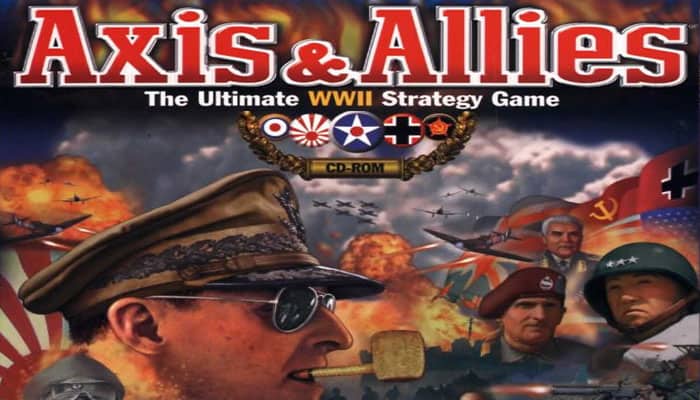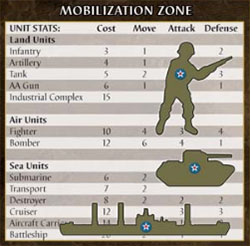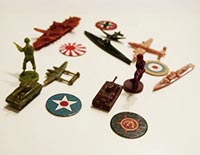

Game Components
- 4 Game Boards
- 7 Game Charts
- 178 Markers and Tokens
- 8 Storage and Boxes
- 14 Dice
- 80 Plastic Chips
- 90 Paper money
- 672 Plastic Miniatures
Game Board
Territories
Each territory is in one of the 3 conditions:
Friendly
A territory with a control marker owned by you or a friendly power.
Hostile
A territory with a control marker owned by an enemy power
Neutral
A territory that has no IPC value or national control symbol and that is not controlled by any power.
They are impassable, so you can not attack them or even move into or over them.
Most territories have an income (IPC = industrial production certificates) ranging from 1 tot 12. Each turn you can move the controller with this value. A few territories like Gibraltar have no IPC.
Sea Zones
Sea zones are friendly or hostile (with enemy surface warships).
Note: The presence of enemy submarines and/or transports don't make a sea zone hostile.
Islands
This is a territory located inside one sea zone. Air units can land on them and land-based troops can disembark on islands.
Canals
There are two canals: the Panama Canal and the Suez Canal. They connect two seas or ocean's but don't block land units.
To move sea units through a canal, your side must control it at the start of your turn.
Victory Cities
There are 18 victory cities on the map, based on their historical importance (industrial, strategic, other) in 1942.
Each city has a corresponding token which is exchanged when the territory is lost or won.
Combat Forces
| Power | Color | |
|---|---|---|
 | United States of America | Green |
 | Germany | Gray |
 | United Kingdom | Tan |
 | Japan | Orange |
 | Soviet Union | Maroon |
 | Italy | Brown |
 | China | Light Green |
Antiaircraft guns and industrial complexes are light gray.
Setup
Assign a power or powers to each player.
Two Players - Player 1: Germany, Italy, Japan
- Player 2: Soviet Union, United Kingdom, United States
Three Players - Player 1: Germany, Italy
- Player 2: Japan
- Player 3: Soviet Union, United Kingdom, United States
Four Players - Player 1: Germany, Italy
- Player 2: Japan
- Player 3: United Kingdom
- Player 4: Soviet Union, United States
Five Players - Player 1: Germany, Italy
- Player 2: Japan
- Player 3: Soviet Union
- Player 4: United Kingdom
- Player 5: United States
Six Players - Player 1: Germany
- Player 2: Japan
- Player 3: Italy
- Player 4: Soviet Union
- Player 5: United Kingdom
- Player 6: United States
Take the national setup chart, markers and pieces that belong to your power
The Axis players sit in the southern edge of the map, the Allies near the top (north) of the board.
The battle board should be placed next to the game board and the dice next to the battle board.
National production/research charts should be also next to the game board.
Each player gets the victory city tokens and IPC's that correspond to the powers.
1941 Scenario
| Power | Victory City Tokens | Starting IPCs | |
|---|---|---|---|
| Germany | Berlin, Paris, Warsaw | 31 | |
| Japan | Tokyo and Shanghai | 17 | |
| Italy | Rome | 10 | |
| United States | Washington, San Francisco, Honolulu and Manila | 40 | |
| United Kingdom | London, Calcutta, Sydney, Hong Kong and Ottawa | 43 | |
| Soviet Union | Moscow, Stalingrad, and Leningrad | 30 |
1942 Scenario
| Power | Victory City Tokens | Starting IPCs | |
|---|---|---|---|
| Germany | Berlin, Paris, Warsaw | 31 | |
| Japan | Tokyo and Shanghai | 31 | |
| Italy | Rome | 10 | |
| United States | Washington, San Francisco and Honolulu | 38 | |
| United Kingdom | London, Calcutta, Sydney and Ottawa | 31 | |
| Soviet Union | Moscow, Stalingrad, and Leningrad | 24 |
China

The U.S. player takes China's turn at the same time as the U.S. turn but Chinese unit combat and movement are done separately from the U.S. forces.
The IPC values printed on the Chinese territories indicate the number of IPCs an Axis player will receive when taking control of the territory while China gets one new infantry unit per turn for every two Chinese territories that are not under Axis control during the Purchase Units phase of the U.S. player's turn.
Chinese units have a limited range of occupation, displayed by the colored border. They can also be moved into Kiangsu and Manchuria.
Chinese units cannot be loaded onto transports.
Kwangtung is a special case because it is not a Chinese territory and cannot be controlled by China. Chinese forces can attack Axis units there and occupy it, but the IPCs generated go to the United Kingdom. This is the only non-Chinese territory that Chinese units may occupy.
Order of Play
The order that players take turns depends on the scenario:
1941 Scenario
 Germany
Germany Soviet Union
Soviet Union Japan
Japan United Kingdom
United Kingdom Italy
Italy United States
United States
1942 Scenario
 Japan
Japan Soviet Union
Soviet Union Germany
Germany United Kingdom
United Kingdom Italy
Italy United States
United States
Turn Sequence
Each power's turn has phases:
- Research and Development
- Purchase Troops
- Combat Moves
- Conduct Combat
- Non-combat Moves
- Mobilize New Units
- Collect Income
At the end of the United States player's turn, check for victory. If neither side has won, begin a new round of play.
I. Research and Development
You may attempt to develop improved technologies:
Buy researcher tokens
Each token cost 5 IPC's.
Roll research dice
For each token, you roll one die.
Roll breakthrough die
If you rolled a "6" on any research die, choose one of the two breakthrough charts and roll a die to see which advance you get.
Mark developments
If your research was succesful, place one of your national control markers inside the advancement box. Your new development becomes immediately effective.
Any number of powers may develop the same technology.
II. Purchase Troops

It's time to spend IPCs for extra units. All the units on your power's national setup chart are available for purchase.
Each industrial complex can only produce as many new units as the IPC value indicated on the territory in which it is located, but for each damage it can produce one less unit.
Purchase Units Sequence
Order Units
Select all units you wish to buy.
Pay for Units & Repairs
Pay the total cost of IPC's to the bank. Each damage marker cost 1 IPC to remove.
Place Units in Mobilization Zone
Place the units in the mobilization zone (in Sout Atlantic Ocean).
III. Combat Moves
Move as many of your units into hostile territories or hostile sea zones.
Movement into hostile territories counts as combat movement, even if this territory is not occupied.
You may move units through friendly spaces en route to hostile spaces.
If you move all your units out of a space, you keep control of that space (until an enemy moves into it).
All combat movement happens at the same time. You can not move extra units into a battle during the battle.
Enemy submarines and transports don't block any unit's movement and an attack to that unit is not required.
IV. Conduct Combat
An Allies power can never attack another Allies power (or an Axis power attack another Axis power).
Combat Sequence

Strategic bombing raids
You can bomb the enemy's industrial complexes with your bombers.
After resolving any antiaircraft fire, suriving bombers each roll one die. The total is the number of damage markers that are placed under the attacked industrial complex.
A bomber that performed a strategic bombing raid, may not participate in any other combat.
Amphibious assaults
Step 1: Sea Combat
If there are defending warships, sea combat must happen first.
If there are only defending submarines or transports, the attacker must choose to combat or not.
If a sea combat occurs, then all attacking sea units participate.
Step 2: Battleship and Cruiser Bombardment
If there was NOT a sea combat, accompanying battleships and cruisers may bombard the coastal territory being attacked.
Roll one die for each battleship and cruiser.
The battleship hits on 4 or less, the cruiser hit on 3 or less.
For each hit, the defender moves a unit to the casualty zone but they will be able to defend during the land combat.
Step 3: Land Combat
Attacking land units can come from the ocean and they can come from adjacent land territories.
If no land units survived the sea combat, or when the attacking sea units withdrew from sea combat, then any other units that participated in the land attack must still conduct one round of land combat before they can retreat.
If the attacker don't have any attacking land units left, the assault is over.
Attacking seaborn units can't retreat!
Attacking overland units must retreat in group at the same time to the same place.
Defending air units can only participate in the land combat, not in the sea combat.
General combat
Combat is resolved by rolling dice according to a standard sequence:
Step 1: Place Units on the Battleboard
The number in a unit's column identifies that unit's attack or defense value.
e.g. An attacking infantry is 1 and een defending infantry is 2.
Cargo does not roll (in sea combat) and is lost when the transport is destroyed.
Step 2: Attacking units fire
Submarines have a surprise strike attack. Both attacking and defending submarines fire before other combat units during a sea battle.
An attacking unit scores a hit when you roll its attack value or less.
After the attacking player has finish rolling, the defending player chooses units for each hit score and move them to the casualty zone.
Step 3: Defending Units Fire
All the units on the defender's side roll one die for each unit with the same defense value at the same time.
A defending unit scores a hit if you roll its defense value or less.
The attacker chooses units for each hit scored and removes it from play.
Step 4: Remove Defender's Casualties
The defender remove the units in the casualty zone from play.
Step 5: Press Attack or Retreat
Combat round 1-4 continue unless:
- Attacker loses all units
- Denfender loses all units
- Attacker retreats
Step 6: Conclude Combat
If you win a combat as attacker and you have one or more land units left, you take control of the territory. Else the defender stays in control.
Air or sea units cannot capture a territory.
Remove the surviving land units from the battle board and place them back on the game board.
When the control of the territory changes, then the control markers and production markers will change too.
An antiaircraft and industrial complex remains in the territory and belongs now to the side of the new owner.
V. Non-combat Move
You can move any of your units that didn't moved in the Combat Move phase.
Move your troops, either to strengthen vulnerable territories or to reinforce units at the front.
Also, all your aicraft that survived the Combat Phase should land now.
Only aircraft and submarines may move through hostile spaces during this phase (to any territory that was friendly at the start of your turn).
VI. Mobilize New Units

Move the newly purchased units from the mobilization zone on the game board to spaces you have controlled since the start of your turn.
You cannot yet use industrial complexes that you captured this turn.
For each industrial complex, you can mobilize only as many units as the IPC income value of the territory containing the industrial complex. This limit includes also the adjacent sea zones.
You cannot place your new units at an industrial complex owned by a friendly power, unless that power's capital is in enemy control and you have taken control of the industrial complex from an enemy power after the friendly power's capital was captured.
Place new industrial complexes in any territory that you have controlled since the start of your turn and that has an income value of at least 1.
You cannot have more than one industrial complex per territory.
If you do not place some of your units the turn you purchase them, they are not lost.

VII. Collect Income
Look up your power's national production level on the national production chart and collect that number of IPCs from the bank.
If your capital is under an enemy's control, you can't collect a bonus income.
A power can NOT lend or give IPC's to another power.
When you have reached your national objectives, you can receive a bonus income of 5 or more IPCs per turn.
End of the Game
At the end of the United States player's turn, check to see if either side has won the game based on the victory condition you are playing.
- Default: 15
- Projection : 13
- Total War: 18
Continue Reading


